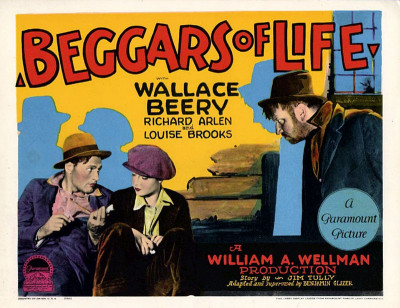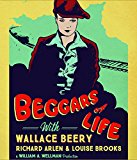| Reviews & Columns |
|
Reviews DVD TV on DVD Blu-ray 4K UHD International DVDs In Theaters Reviews by Studio Video Games Features Collector Series DVDs Easter Egg Database Interviews DVD Talk Radio Feature Articles Columns Anime Talk DVD Savant Horror DVDs The M.O.D. Squad Art House HD Talk Silent DVD
|
DVD Talk Forum |
|
|
| Resources |
|
DVD Price Search Customer Service #'s RCE Info Links |
|
Columns
|
|
|
Beggars of Life
Unlike The Jazz Singer, Beggars of Life, as with many of the last silent features, was shot as a silent movie, only to have talking scenes shoehorned into the film once Al Jolson's seminal musical changed the movie industry overnight. Wellman didn't care for these alterations, and so Kino's release of this George Eastman Museum restoration is Wellman's original, 81-minute silent version (with musical scoring) rather than the 100-minute part-talkie version. It's not clear why the talking sequences added later weren't included on this release as an extra feature - their addition would have been invaluable - but Wellman's film is very good, if not on the same level as his later masterpieces covering similar territory, particularly Wild Boys of the Road and Heroes for Sale (both 1933).
Another big draw for viewers is iconic silent star Louise Brooks, whose best American film this was before leaving the country to star in two films that solidified her status as a silent movie icon: Pandora's Box and Diary of a Lost Girl (both 1929) for G.W. Pabst.
A hungry hobo, Jim (Richard Arlen of Wings and Island of Lost Souls, billed in the credits as "The Boy"), approaches a farmhouse to beg for food, but is shocked to discover that the man seated at the kitchen table inside is dead, shot in the head by Nancy (Brooks, billed as "The Girl"). In flashbacks, she explains that her foster father had repeatedly attempted to molest her, leaving her no choice but to defend herself.
Jim agrees to help Nancy escape by disguising her as a teenage boy hobo and riding the rails to comparative safety across the border into Canada. The pair soon encounters a group of tough-looking tramps led by Arkansas Snake (Robert Perry) and his rival, Oklahoma Red (top-billed Wallace Beery). Not that it was difficult, but the hobos quickly realize that Jim's male companion is really a beautiful young woman, threaten gang rape, and put the pair through a mock trial.
Just as injustice is being meted, detectives trying to capture fugitive Nancy break up the melee. Red unlatches the last two cars and caboose, and the hobos take refuge in an abandoned shack where Red has an epiphany: Jim and Nancy are in love, something he's never encountered in all his travels.
Wellman's later Wild Boys of the Road and especially Heroes for Sale are much bleaker and hard-hitting, made as they were in the throes of the Great Depression, while Beggars of Life was produced just prior to the Stock Market Crash. Probably for that reason, his depiction of hobo life and riding the rails is much more romanticized here. Though Wellman reportedly cast real hobos as background extras, they're broad caricatures and the mock trial wildly over the top and pretty hard to take. Further, Brooks is never remotely believable as a teenage boy, with little effort made to hide her unique beauty. (Then again, it worked later for Preston Sturges and Veronica Lake in Sullivan's Travels, clearly influenced by Wellman's movie.)
That said, the film still packs a pretty powerful punch in numerous ways. Some aspects of hobo life are realistically shown, such as ruthless brakeman determined to rid their trains of the pestilent tramps, the brakemen depicted here nearly as ruthless as Ernest Borgnine in Emperor of the North (1973). The opening scenes of Jim finding the dead body and flashbacks of Nancy's horrific relationship with her adopted sexual predator father are still pretty startling. In his later sound films Wallace Beery had a tendency to overact, but here his performance is extraordinarily modern and subtle. His bewilderment at Jim and Nancy's devotion to one another, he willing to die trying to protect her, a murderess (however justified), makes him look at the world in ways he'd never considered before. Beery's subtle facial gestures put the audience inside the character's head, and his good-bad guy character ultimately comes off as rather touching. (Without revealing anything, the movie even anticipates John Ford's late masterpiece The Man Who Shot Liberty Valance in a couple of respects.) Arlen is fine and while Brooks doesn't convince as a boy there's no question she lights up the screen and is a more nuanced and sensuous actress than most of her generation.
Video & Audio
Beggars of Life is presented in its original 1.34:1 aspect ratio, featuring a new DTS-HD Master Audio 2.0 stereo score compiled and performed by The Mont Alto Motion Picture Orchestra, partly incorporating elements from Paramount's original cue sheets from 1928. The image is reasonably strong, not perfect but quite good throughout. The region "A" disc uses English intertitles.
Extra Features
The fine supplements include two good commentary tracks, one by William Wellman, Jr., and the other by Thomas Gladysz of the Louise Brooks Society. An excellent booklet essay by Nick Pinkerton puts the film into historical context.
Parting Thoughts
Sentimental and gritty at once, Beggars of Life is a real find, a still entertaining and even moving silent melodrama from the great director William A. Wellman. A DVD Talk Collector Series title.
Stuart Galbraith IV is the Kyoto-based film historian largely absent from reviewing these days while he restores a 200-year-old Japanese farmhouse.
|
| Popular Reviews |
| Sponsored Links |
|
|
| Sponsored Links |
|
|
| Release List | Reviews | Shop | Newsletter | Forum | DVD Giveaways | Blu-Ray | Advertise |
|
Copyright 2024 DVDTalk.com All Rights Reserved. Legal Info, Privacy Policy, Terms of Use,
Manage Preferences,
Your Privacy Choices | |||||||












